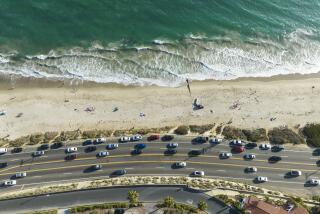Raw Sewage Continues to Spill Into Conejo Creek
- Share via
THOUSAND OAKS — Millions of gallons of raw sewage continued to flow from a storm-damaged pipe into Conejo Creek on Wednesday, prompting concerns among environmentalists about the hazards posed by the spill.
As much as 18 million gallons of effluent could be discharged by the time the spill is expected to be contained by noon Friday, according to officials. This would surpass a 10-million-gallon spill in 1995 from the same Hill Canyon Wastewater Treatment Plant pipe.
“It sounds worse than we originally thought,” said John Buse, an attorney with the nonprofit Environmental Defense Center. “We need to ask why the plant operators didn’t prevent this.”
Buse said the spill was made worse because it did not rain much Wednesday, which means that the sewage was not diluted as it was when the pipe first ruptured during the previous day’s storm.
Buse said his law firm will investigate the history of spills at the treatment plant and encourage the state Regional Water Quality Control Board to take action if warranted.
He pointed out that Mugu Lagoon--where the sewage will accumulate before draining into the ocean--is a vital coastal wetlands area.
As city employees began repair work Wednesday, state water quality inspectors gathered samples from the creek that runs past the treatment plant. Downstream, county environmental health workers posted warning signs along the creek and on beaches where the waste will end up.
Tuesday’s continued downpour delayed attempts to locate the rupture in the pipe, which is in the creek bed, city Public Works Director Don Nelson said. Crews were only able to get to it Wednesday morning. The plan now, he said, is to build a small dam to divert creek water around the pipe.
A contractor will inspect the damage and determine “the best and quickest way to repair it,” Nelson said. Crews will then pour concrete around the pipe to prevent water from getting in the seam joining the 10-foot sections, he said.
Veronica Cuevas-Alpuche, the water board engineer investigating the spill, said it appears that it was accidental and that facility operators were diligent in maintaining the pipe. She said that public works was planning to replace the pipe this summer and that the storm was a stroke of bad luck.
After water quality tests are completed in two weeks, Cuevas-Alpuche will forward her report to the standards and enforcement unit of her agency.
Still, she acknowledged, Mugu Lagoon is badly polluted by whatever comes down the Calleguas Creek watershed, of which Conejo Creek is a part. Pesticides adhere to the lagoon’s sediments and take a long time to break down. In addition to agricultural runoff and sewage spills, the lagoon absorbs upstream chemical spills.
About 49,000 gallons of ethylene glycol, an antifreeze, spilled from the Rockwell Science Center in Thousand Oaks into an upper tributary in December 1996.
“Everything ends up there,” Cuevas-Alpuche said of the lagoon.
High bacteria counts can reduce the amount of oxygen in the lagoon’s water, upsetting the balance of its ecosystem, according to biologist Walter Wehtje. Algae growth would cause fish and other aquatic life to suffocate. If the sewage gets into the lagoon’s inner pools, the water may stand for a period of time. Animals that drink the contaminated water could develop infections, he said.
Surfers have long blamed bacteria for the ear and sinus infections, skin rashes and flu-like symptoms they suffer after surfing in runoff-polluted ocean waters.
* DISASTER AREA: Gov. Pete Wilson declared the county a disaster area. A1
* RECOVERY: Residents of damaged homes seek quick resolution. B4
More to Read
Sign up for Essential California
The most important California stories and recommendations in your inbox every morning.
You may occasionally receive promotional content from the Los Angeles Times.













